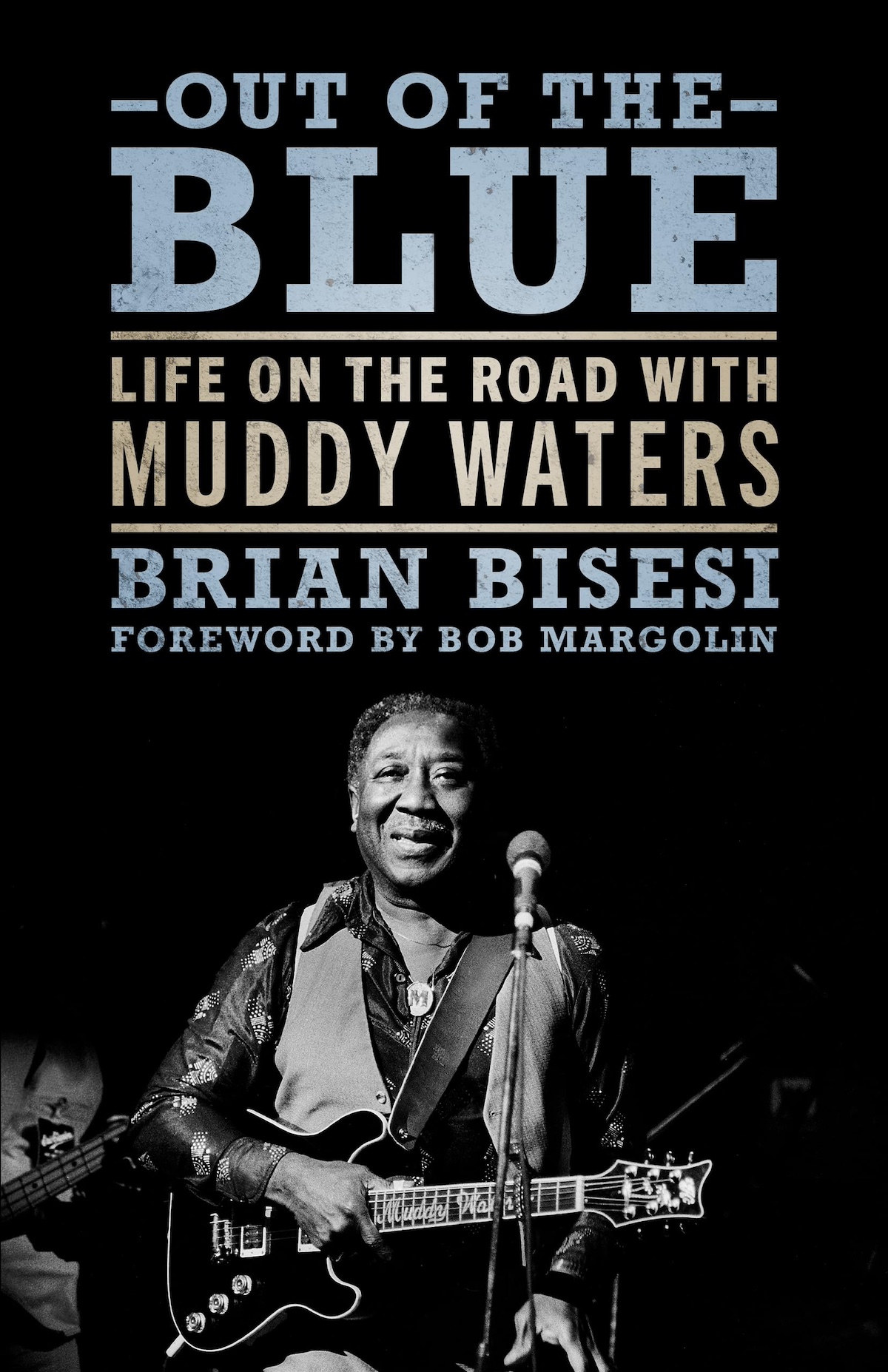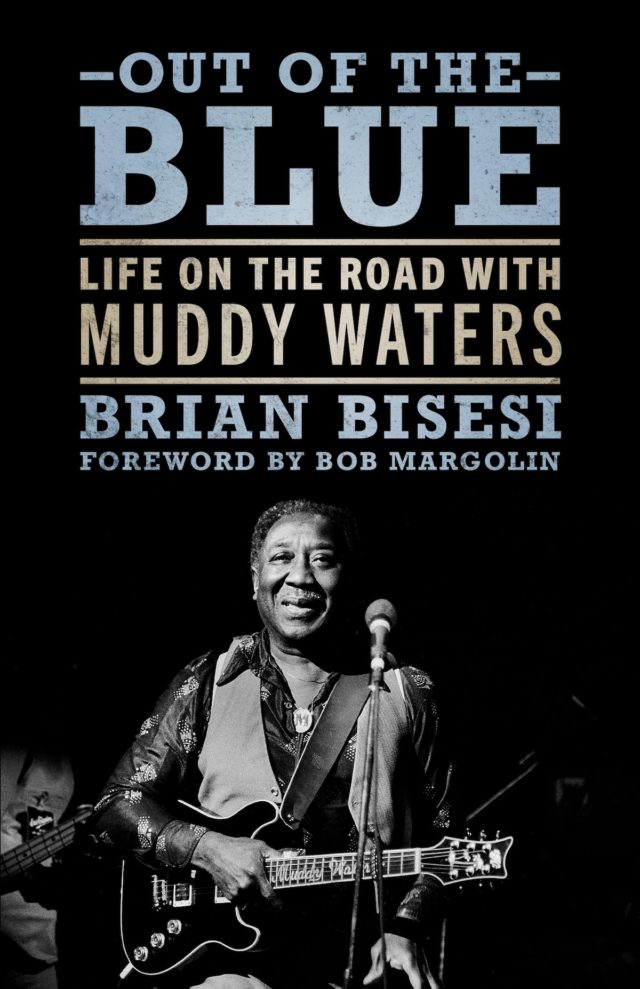Muddy roads, fab females, a Bowie bio, music movies and more new additions to your reading list. Lights, camera, rock!
 Out of the Blue: Life On The Road with Muddy Waters
Out of the Blue: Life On The Road with Muddy Waters
By Brian Bisesi
THE EDITED PRESS RELEASE: “Out Of The Blue: Life On The Road With Muddy Waters begins with a moment lifted from a young musician’s dreams. Brian Bisesi, a guitarist barely out of his teens, is invited on stage to fill in for a missing member of the band backing blues legend Muddy Waters. This life-changing quirk of fate opens the door into a world of challenges and opportunities that Bisesi, an Italian American reared in the comforts of a New York City suburb, can barely imagine. Despite their differences, Bisesi and Waters hit it off, and what might have been a one-night stand turns into a career. From 1978 to 1980, Bisesi works for Waters as his road manager, bean-counter, and at times his confidant, while often sitting in with the band. Bisesi’s years with the band take him to Europe, Japan, Canada, and across the United States as Waters tours — and parties — with rock gods like Eric Clapton, The Rolling Stones, one of The Beatles, and the gamut of musicians who came of age with Waters and introduced a younger generation to the blues. Bisesi captures it all: from the pranks and tensions among bluesmen enduring a hard life on the road, to observations about Waters’s technique, his love of champagne and reefer, his eye for women, and his sometimes-acrid views of contemporary music. Bisesi has sharp insights into the ill-conceived management decisions that led to the dissolution of Waters’s longest-serving band in June of 1980. This book will rivet, amuse, and occasionally infuriate blues aficionados. It is a raucous and intimate portrait of the blues scene at a pivotal moment in time that fascinates music historians and blues fans alike.”
 The Other Fab Four: The Remarkable True Story Of The Liverbirds, Britain’s First Female Rock Band
The Other Fab Four: The Remarkable True Story Of The Liverbirds, Britain’s First Female Rock Band
By Mary McGlory & Sylvia Saunders
THE EDITED PRESS RELEASE: “The idea for Britain’s first female rock band, The Liverbirds, started one evening in 1962, when Mary McGlory, then age 16, saw The Beatles play live at The Cavern Club in Liverpool, the nightclub famously known as the “cradle of British pop music.” Then and there, she decided she was going to be just like them — and be the first girl to do it. Joining ranks in 1963 with three other working-class girls from Liverpool — drummer Sylvia Saunders and guitarists Valerie Gell and Pamela Birch, also self-taught musicians determined to “break the male monopoly of the beat world” — The Liverbirds went on to tour alongside The Rolling Stones, The Kinks and Chuck Berry, and were on track to hit international stardom — until life intervened, and the group was forced to disband just five years after forming in 1968. Now, Mary and Sylvia, the band’s two surviving members, are ready to tell their stories. From that fateful night in 1962, when Mary, who once aspired to become a nun, decided to provide for her family by becoming a rich-and-famous rocker, to the circumstances that led to the band splitting up — Sylvia’s dangerously complicated pregnancy, and the tragic accident that paralyzed Valerie’s beau — The Liverbirds tackles family, friendship, addiction, aging, and the forces (including destiny) that initially brought the four women together.”
 David Bowie: The Biography
David Bowie: The Biography
By United Library
THE EDITED PRESS RELEASE: “Delve into the extraordinary life and unparalleled legacy of David Bowie, the iconic English singer, songwriter, and actor, in this compelling biography. Born David Robert Jones on Jan. 8, 1947, Bowie transcended the boundaries of music and art, leaving an indelible mark on the 20th century as one of its most influential musicians. From his early struggles with local bands and a solo album to the groundbreaking success of Space Oddity (1969), Bowie’s career was a continuous journey of reinvention. The glam era saw the emergence of his flamboyant alter ego Ziggy Stardust, captivating audiences with hits like Starman and The Rise and Fall of Ziggy Stardust and the Spiders from Mars. His evolution continued with the “plastic soul” sound of Fame and Young Americans, and later the electronic-inflected albums of the Berlin Trilogy. Bowie’s impact expanded beyond music; he became a cinematic force with roles in films like The Man Who Fell to Earth (1976) and Labyrinth (1986). Achieving commercial zenith with Let’s Dance (1983), he navigated the 1980s and 1990s with diverse experimentation in music and continued acting endeavors. Revered for his chameleon-like ability to reinvent his musical persona, Bowie’s journey culminated in his final masterpiece, Blackstar, released just days before his death from liver cancer in 2016.”
 Loud Pictures: A History Of The Cinema Of Rebellion And The Greatest Rock And Roll Films of All Time
Loud Pictures: A History Of The Cinema Of Rebellion And The Greatest Rock And Roll Films of All Time
By Marc Spitz
THE EDITED PRESS RELEASE: “In a long line of beloved books, Loud Pictures stands as Marc Spitz’s final project. This big, broad, noisy, and expansive exploration of art marries the two things Marc loved most — movies and rock ’n’ roll. In many ways, films can become imprinted on our brains because of their soundtracks. And songs in films take on different meanings because of the scenes associated with them. Loud Pictures explains, explores, and celebrates that symbiotic relationship through interviews with directors, actors, music supervisors, critics, and many more. Films with nostalgic undertones such as Say Anything, Purple Rain, Trainspotting, The Rocky Horror Picture Show, Taxi Driver, A Hard Day’s Night, Shaft, Saturday Night Fever, Postcards From the Edge, Dirty Dancing, Nashville, Blow Up, and hundreds more, are sprinkled throughout these pages, perfectly capturing moments in time where the intersection between film and music have shined the brightest. The completion of Loud Pictures would not have been possible without the aid of Lizzy Goodman, author of Dey Street’s Meet Me In The Bathroom, and Rolling Stone contributing editor Rob Sheffield.”
 Zip It Up!: The Best Of Trouser Press Magazine 1974 – 1984
Zip It Up!: The Best Of Trouser Press Magazine 1974 – 1984
By Ira Robbins
THE EDITED PRESS RELEASE: “Trouser Press magazine began as a mimeographed fanzine in March 1974 and grew to a 60,000-circulation glossy rock music monthly. Started by two high school Who-freak friends and a Jeff Beck fanatic they’d recently met, Trouser Press published 96 issues over the following decade, covering everything from British Invasion bands, ’70s arena rock and prog to punk, new wave, synth-pop, post-punk and reggae. Zip It Up! The Best of Trouser Press Magazine 1974-1984 is an annotated anthology of the music writing that appeared in the magazine. Annotated with recollections and reflections on the changing times, the ridiculous business of independent magazine publishing and the colorful, complicated artists — illustrated with cartoons, covers, documents and ads from the Trouser Press archive — Zip It Up! is vintage rock journalism of a form that is no longer widely practiced: Features heavy on historical detail and lengthy, probing interviews, all written with wit, intelligence and a willful expression of opinions and values. It is also an extensive document of rock’s evolution from the 1970s to the mid-’80s, often capturing now-iconic bands in the early stages of their existence. By turns reverent, snarky, adulatory and cynical, Zip It Up! is a rich grazing ground for fans and students of music and music journalism.”
 At the Vanguard of Vinyl: A Cultural History of the Long-Playing Record in Jazz
At the Vanguard of Vinyl: A Cultural History of the Long-Playing Record in Jazz
By Darren Mueller
THE EDITED PRESS RELEASE: “In At the Vanguard of Vinyl, Darren Mueller examines how the advent of the long-playing record in 1948 revolutionized the recording and production of jazz in the 1950s. The LP’s increased fidelity and playback capacity allowed lengthy compositions and extended improvisations to fit onto a single record, ushering in a period of artistic exploration. Despite these innovations, LP production became another site of negotiating the uneven power relations of a heavily segregated music industry. Exploring how musicians, producers, and other industry professionals navigated these dynamics, Mueller contends that the practice of making LPs significantly changed how jazz was created, heard, and understood in the 1950s and beyond. By attending to the details of audio production, he reveals how Black musicians such as Louis Armstrong, Miles Davis, Duke Ellington and Charles Mingus worked to redefine prevailing notions of race and cultural difference within the U.S. Mueller demonstrates that the LP emerges as a medium of sound and culture that maps onto the more expansive sonic terrain of Black modernity in the 1950s.”










































